Official Newsjournal of the Illinois Council of Health-System Pharmacists
Emergency Response Drill through the Illinois Health-System Pharmacy Response Network (HSPRN)
Feature Article
by Cindy Li, PharmD candidate, ICHP student intern
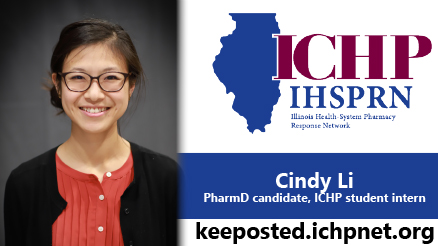
Introduction
The year 2017 was one in which the United States saw many natural disasters. Hurricanes ravaged the gulf coast and Puerto Rico and wildfires blazed through California. These disasters not only brought destruction to buildings and infrastructure, but also caused illness and injuries in victims living in those areas, resulting in public health crises. Many pharmacies in these affected areas were forced to close due to flooding, dangerous conditions, and loss of power, causing patients to lose access to necessary medication. Pharmacists in surrounding areas cooperated with state agencies and professional organizations to restore access to those medications to as many patients as they could reach.
The goal of the Illinois Health-System Pharmacy Response Network (IHSPRN) is to respond to similar crises across the state of Illinois. IHSPRN may act in conjunction with state agencies such as the Illinois Department of Public Health (IDPH), the Illinois Medical Reserve Corps, and the Illinois Emergency Management Agency (IEMA) to mobilize pharmacy resources and personnel to respond to disasters, epidemics, chemical spills, bioterrorism, and other emergencies.
Individuals who are injured or wounded after a natural disaster should be assessed for risk of various infections and illnesses. This assessment includes evaluation of their medical history as well as the severity of the injury or wound. Individuals with unknown or incomplete vaccination history should be given prophylaxis for tetanus and other infections. Special populations who are especially susceptible to tetanus infections include individuals above the age of 50 years, especially women, and individuals with diabetes. Children under the age of six years with unknown or incomplete vaccination status should receive DTaP, while children over the age of six and adults should receive Tdap or Td (Figure 1). For wounds that are severe or contaminated, tetanus immune globulin (TIG) should be given in addition to the vaccine.
The purpose of this drill was to evaluate various factors such as response time, establishment of an emergency protocol, and inventory status of various pharmacies across Illinois. This drill also served as a practice exercise to simulate an event in the state of Illinois in which pharmacists and pharmacy technicians must respond with inventory counts of various medications within a limited time frame.
Methods
A list of all pharmacies licensed in Illinois was obtained from the Illinois Department of Financial and Professional Regulation (IDFPR). Pharmacies on the list were contacted via an email SurveyMonkey link and/or fax, requesting contact information for the primary and secondary persons responsible for emergency preparedness at the pharmacy. Pharmacies were given options to participate in the drill via email, participate via fax, or opt out of the drill. A reminder to complete the SurveyMonkey form was sent one week prior to the drill. Pharmacies were excluded if they were no longer active, not in the state of Illinois, or community chain pharmacies that had their own emergency protocol dictated by company policy.
A postcard containing the date and information regarding the emergency drill was mailed to all eligible pharmacies. This postcard contained instructions to update the contact information for the primary and secondary persons responsible for emergency preparedness via phone or email. This postcard was postmarked three weeks before the drill.
On the day of the drill, those emergency contacts who opted in were sent a SurveyMonkey link or a fax sheet, depending on their preference indicated earlier. The questionnaire requested the total number of doses of Tdap, Td, DT, and DTaP vaccines, as well as the total number of doses of tetanus immune globulin (TIG) vaccines currently in the pharmacy’s inventory. The questionnaire also asked for the pharmacies to indicate the presence or absence of an established emergency protocol for the event of a tornado or flood in the local area, specifying whether the protocol accounts for damage in the pharmacy.
Following the drill, an email was sent to all respondents informing them of the median response time, the percentage of respondents who did not have an emergency protocol, and the rationale for choosing tetanus vaccines and tetanus immune globulin. The email contained a SurveyMonkey link where participants may provide feedback.
Results
Out of 135 pharmacies that opted in to the drill, 69 pharmacies within 26 counties responded (Figure 2). Ten counties did not have any available inventory. Respondents in Illinois had a total of 2,324 doses of Tdap, 351 doses of Td, 118 doses of DTaP, 30 doses of DT, and 73 doses of TIG.
Response times ranged from less than one hour to 74 hours (Figure 3). The average response time was six hours, and the median response time was one hour. 85.5% of respondents responded within 7 hours.
A total of 36 pharmacies (52%) that responded to the drill had an emergency protocol in place for the event of a tornado or flood that includes damage to the pharmacy. Ten pharmacies (14%) that responded to the drill had an emergency protocol in place for the event of a tornado or flood in the local area that does not include damage to the pharmacy. Three pharmacies (4%) had both protocols, and 26 pharmacies (38%) did not have a protocol in place for the event of a tornado or flood (Figure 7).
Discussion
One of the primary concerns regarding the results of the drill was the low participation rate. Even though an incentive was given to all who completed the drill (entry into a drawing for a $25 Amazon gift card), potential participants were not informed of it until the email reminder on SurveyMonkey was sent. Because the emails of some pharmacies were not available, not all pharmacies were informed of the incentive until the day of the drill, when they were informed via the drill form. Despite this incentive, only 69 out of 135 pharmacies that opted in to the drill completed the drill form (Figure 2). Because there were few respondents to the evaluation survey following the drill, the reason for low response percentage was unknown, but may be due to a high workload within the pharmacy, lack of confidence in the drill, the perception that the drill was not important or urgent, the perception that a response is not necessary due to a lack of inventory, or transmission error.
In the event of an emergency, response time can be crucial. Of the pharmacies that responded, the majority (85.5%) of them responded within seven hours (Figure 3). This is a realistic time frame in which IHSPRN could relay the data to state agencies that may then begin to coordinate transport of necessary medications to the site of the emergency in a timely manner.
The distribution of counties that responded to the drill is relatively even across Illinois (Figure 4). However, only 16 of 26 counties that responded had medications available to be distributed. Depending on the type of pharmacy that responds and the medication needed, time of transport is a crucial factor in giving affected patients access to necessary medications in a timely manner. Pharmacies closer to the site of the emergency will be able to respond faster to the emergency. However, those pharmacies may also be affected by the disaster.
The establishment of an emergency protocol in the event of a tornado or flood, both likely occurrences in the state if Illinois, could benefit pharmacies and the public greatly in the event of an emergency. Pharmacies sustaining damage from an emergency will benefit from a safe evacuation protocol of its customers and workers. This protocol may be as simple as establishing a chain of command and evacuation route(s) enabling pharmacy personnel and patients to get to an area of safety. Pharmacies that do not sustain damage in an emergency may act as valuable resources in the community. Pharmacists may give immunizations and supply medications to other facilities or patients that have trouble accessing maintenance or emergency medications.
Figure 1
Tetanus Prevention After a Disaster
(CDC; accessed 5/31/18)
|
Age (years) |
Vaccination history |
Clean, minor wounds |
All other wounds |
|
0 through 6 |
Unknown or not up-to-date on DTaP series based on age |
DTaP |
DTaP TIG |
|
Up-to-date on DTaP series based on age |
No indication |
No indication |
|
|
7 through 10 |
Unknown or incomplete DTaP series |
Tdap and recommended catch-up vaccination |
Tdap and recommended catch-up vaccination TIG |
|
Completed DTaP series AND <5 years since last dose |
No indication |
No indication |
|
|
Completed DTaP series AND >/= 5 years since last dose |
No indication |
Td, but Tdap preferred if child is 10 years of age |
|
|
11 years and older |
Unknown or <3 doses of tetanus toxoid containing vaccine |
Tdap and recommended catch-up vaccination |
Tdap and recommended catch-up vaccination TIG |
|
3 or more doses of tetanus toxoid containing vaccine AND <5 years since last dose |
No indication |
No indication |
|
|
3 or more doses of tetanus toxoid containing vaccine AND 5-10 years since last dose |
No indication |
Tdap preferred (if not yet received) or Td |
|
|
3 or more doses of tetanus toxoid containing vaccine AND >10 years since last dose |
Tdap preferred (if not received) or Td |
Tdap preferred (if not yet received) or Td |
Figure 2
Emergency Response Drill Flow Diagram
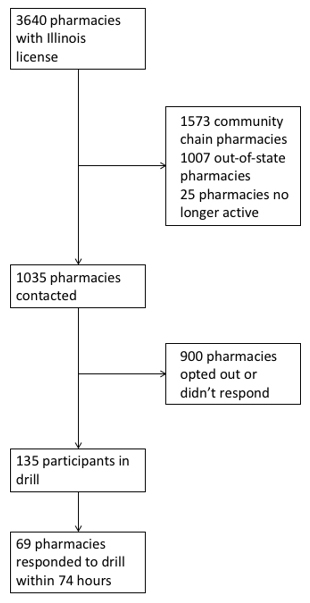
Figure 3
Response Times for All Pharmacies Completing Drill
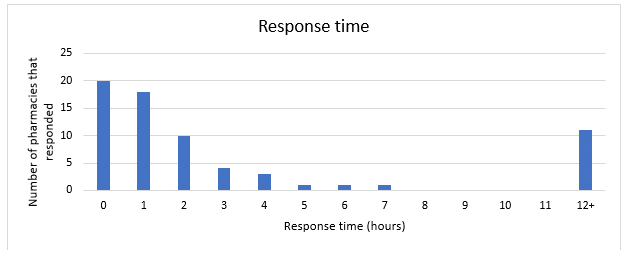
Figure 4
Illinois Counties in which Pharmacies Responded to the Drill*
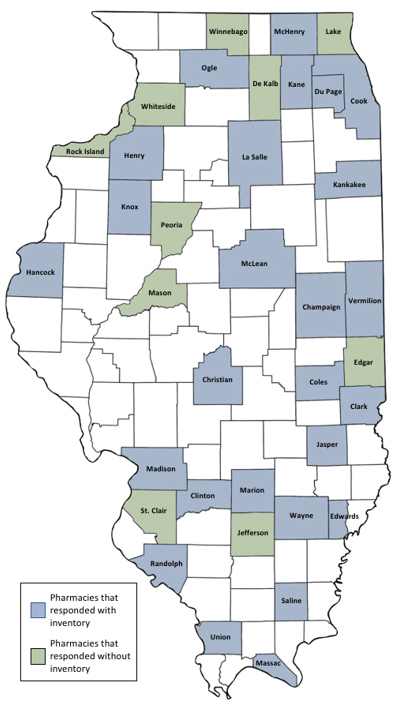
*Counties in which pharmacies responded with available inventory are highlighted in blue, while counties in which pharmacies responded with no available inventory are highlighted in green.
Figure 5
Total Inventory Counts of Pharmacies Responding
to Drill by County.
|
County |
Tdap |
Td |
DTaP |
DT |
TIG |
# of Pharmacies Responding |
|
Champaign |
1530 |
90 |
0 |
0 |
0 |
1 |
|
Christian |
12 |
7 |
0 |
0 |
1 |
1 |
|
Clark |
10 |
0 |
0 |
0 |
0 |
1 |
|
Clinton |
13 |
0 |
0 |
0 |
0 |
2 |
|
Coles |
37 |
7 |
0 |
0 |
2 |
1 |
|
Cook |
352 |
103 |
79 |
10 |
1 |
16 |
|
DeKalb |
0 |
0 |
0 |
0 |
0 |
1 |
|
Dupage |
3 |
0 |
0 |
0 |
0 |
4 |
|
Edgar |
0 |
0 |
0 |
0 |
0 |
1 |
|
Edwards |
5 |
0 |
0 |
0 |
0 |
1 |
|
Hancock |
2 |
0 |
0 |
0 |
0 |
1 |
|
Henry |
8 |
0 |
0 |
0 |
0 |
2 |
|
Jasper |
9 |
0 |
0 |
0 |
0 |
1 |
|
Jefferson |
0 |
0 |
0 |
0 |
0 |
1 |
|
Kane |
50 |
11 |
10 |
0 |
5 |
2 |
|
Kankakee |
0 |
4 |
0 |
0 |
0 |
3 |
|
Knox |
35 |
0 |
0 |
16 |
2 |
1 |
|
LaSalle |
5 |
0 |
0 |
0 |
0 |
2 |
|
Lake |
0 |
0 |
0 |
0 |
0 |
2 |
|
Madison |
91 |
26 |
0 |
4 |
12 |
5 |
|
Marion |
26 |
0 |
0 |
0 |
1 |
2 |
|
Mason |
0 |
0 |
0 |
0 |
0 |
1 |
|
Massac |
28 |
25 |
10 |
0 |
0 |
1 |
|
McHenry |
0 |
24 |
0 |
0 |
1 |
1 |
|
McLean |
10 |
18 |
0 |
0 |
1 |
1 |
|
Ogle |
20 |
14 |
0 |
0 |
15 |
1 |
|
Peoria |
0 |
0 |
0 |
0 |
0 |
1 |
|
Randolph |
10 |
6 |
0 |
0 |
1 |
1 |
|
Rock Island |
0 |
0 |
0 |
0 |
0 |
1 |
|
Saint Clair |
0 |
0 |
0 |
0 |
0 |
3 |
|
Saline |
1 |
0 |
0 |
0 |
0 |
1 |
|
Union |
20 |
6 |
9 |
0 |
0 |
1 |
|
Vermilion |
37 |
0 |
0 |
0 |
4 |
1 |
|
Wayne |
10 |
10 |
10 |
0 |
2 |
2 |
|
Whiteside |
0 |
0 |
0 |
0 |
0 |
1 |
|
Winnebago |
0 |
0 |
0 |
0 |
0 |
1 |
Figure 6
Total Inventory Counts of Pharmacies Responding to Drill by Tier (Category)
|
Tier (Category) |
Tdap |
Td |
DTaP |
DT |
TIG |
# of Pharmacies Responding |
|
1 – Hospital Inpatient |
2065 |
280 |
118 |
26 |
65 |
22 |
|
2 – Mental Health Hospital |
0 |
11 |
0 |
0 |
0 |
1 |
|
4 – Independent |
81 |
0 |
0 |
4 |
8 |
36 |
|
5 – Home Care or Long-Term Care |
0 |
4 |
0 |
0 |
0 |
5 |
|
6 – Outpatient or within a clinic |
178 |
56 |
0 |
0 |
0 |
5 |
|
Total |
2324 |
351 |
118 |
30 |
73 |
69 |
Figure 7
Pharmacies' Indication of the Presence or Absence of Protocol(s) in the Event of a Tornado or Flood in the Local Area
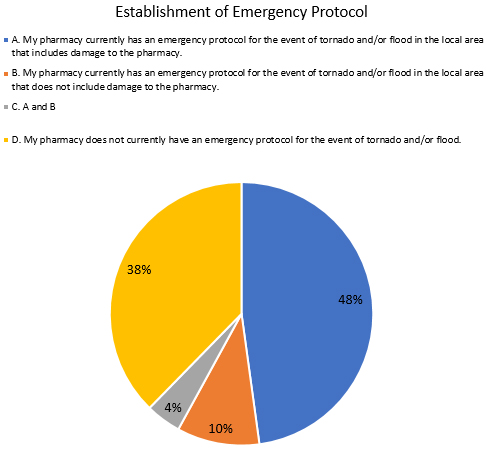
References
Bell C, Daniel S. Pharmacy leader's role in hospital emergency preparedness planning. Hosp Pharm. 2014;49(4):398-404.
Alkhalili M, Ma J, Grenier S. Defining roles for pharmacy personnel in disaster response and emergency preparedness. Disaster Med Public Health Prep. 2017;11(4):496-504.
Centers for Disease Control and Prevention. Tetanus prevention after a disaster. (2015, August 25). Retrieved from https://www.cdc.gov/disasters/disease/tetanus.html.
Texas Board of Pharmacy. Hurricane Harvey emergency dispensing of prescription medications. (August 2017). Retrieved from https://www.pharmacy.texas.gov/files_pdf/2017_harvey_notification.pdf.
Texas Board of Pharmacy. Information for pharmacies that sustain damage due to Hurricane Harvey. (August 2017). Retrieved from https://www.pharmacy.texas.gov/files_pdf/2017_integrity_of_medicaiton.pdf.
Acknowledgements
I would like to thank everybody at the ICHP office for all of your help and input on this project. This internship has been an invaluable experience for me, in which I learned a lot about how emergency response in the state and national levels operate. Heidi and Melissa, thank you for all of your help on the postcards. Maggie and Jo, thanks for showing me how everything works around the office. Trish and Scott, thank you for your input on the materials I sent out to the pharmacies. Jan, THANK YOU for figuring out the fax machine!
Contents
Columns
Elevate Your Meeting Experience!
Features
Emergency Response Drill through the Illinois Health-System Pharmacy Response Network (HSPRN)
Our New ICHP Communications Manager
Time to Celebrate for Pharmacy!
College Connection
Chicago State University - College of Pharmacy
Midwestern University Chicago College of Pharmacy
Rosalind Franklin University of Medicine and Science College of Pharmacy
More
ICHP Pharmacy Action Fund (PAC)
Officers and Board of Directors
Regularly Scheduled Network Meetings
Chicago Area Pharmacy Directors Network Dinner
3rd Thursday of Odd Months
5:30pm
Regularly Scheduled Division and Committee Calls
Executive Committee
Second Tuesday of each month at 7:00 p.m.
Educational Affairs
Third Tuesday of each month at 11:00 a.m.
Government Affairs
Third Monday of each month at 5:00 p.m.
Marketing Affairs
Third Tuesday of each month at 8:00 a.m.
Organizational Affairs
Fourth Thursday of each month at 12:00 p.m.
Professional Affairs
Fourth Thursday of each month at 2:00 p.m.
New Practitioner Network
Second Thursday of each month at 5:30 p.m.
Technology Committee
Second Friday of each month at 8:00 a.m.
Chicago Area Pharmacy Directors Network Dinner
Bi-monthly in odd numbered months with dates to be determined. Invitation only.


